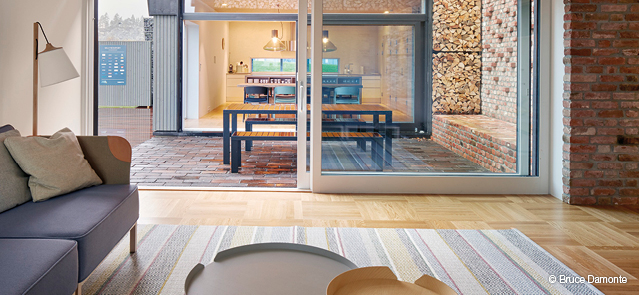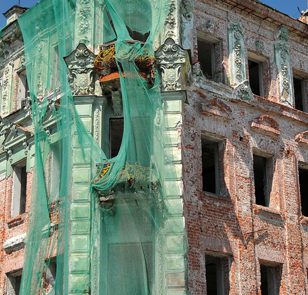One house, two homes / The Home of the Future
June 26, 2015
Fancy housing three generations under one roof? It won’t be so bad if you live in a dual or tri-hub, a home style that’s likely to become increasingly common, according to our Home of the Future research.

We’re going back to the future in our family living arrangements. The number of 3G homes – in which three generations of a family are living together – is growing. In an echo of the 1950s and 60s it will become increasingly common for children, parents and grandparents to live together.
With young people struggling to afford a property and a growing elderly population the trend is set to continue, according to the Hiscox Home of the Future report. Modular design houses have been touted as a solution to the growing problem of building affordable homes with the flexibility to provide extra space to respond to the owner’s changing needs.
It’s all in the stats
Two or more families living in the same home were the fastest growing type of household between 2004 and 2014, increasing by 56% to 313,000 households in 2014, according to government figures.
In a survey by Hiscox, 45% of people polled expect their children to live with them for longer than in previous generations, or to return home. It also found that more than one in 10 Britons foresee their parents coming to live with them in the future. As a result, a house will increasingly become a home within a home for an extended family, with individual living spaces for different relatives in the same house.
Architects and house builders need to help solve the growing problem by creating innovative design solutions to encourage new construction methods, says Mark Crosby, policy advisor at the Royal Institute for British Architects.
“We’re in the middle of the biggest housing crisis ever,” Crosby argues. “The housing industry in the UK hasn’t changed from bricks and mortars for hundreds of years. We’re going to have to innovate.”
Flexible living
The house-building industry is likely to see a burst of innovation similar to that in the automotive industry to meet the surging demand for new housing, Crosby says. New houses need to be built cheaper and quicker, and modular design homes may hold the answer, particularly to creating dual or tri-hub homes, which offer individual living spaces for different generations.
“We’re going to see offsite manufacture and standardised components and prefabrication,” Crosby says.
Modular homes – in which the various component rooms are manufactured in a factory and put together on site, rather like a life-size Lego kit – can offer homebuyers the flexibility they need at a price they can afford. Factory processes mean modular homes are often cheaper and quicker to build than conventional houses, as well as being cheaper to run, because they are more energy efficient.
Also, unlike run-of-the-mill new homes, modular homes can be customised to a buyer’s individual needs and budget. You simply choose the number and type of modules you want or can afford. So, for example, you can select a den for the kids, a separate living room for you and a self-contained annexe for Nan and Grandad with a large communal kitchen.
These homes have the added advantage of being able to adapt to their owners’ changing needs. They can be reconfigured and extended so a homeowner won’t need to have to trade up to a bigger house. If you need extra rooms as your extended family grows, then those can be easily added to a modular home– an extra storey can be added in a matter of days.
“Tomorrow’s home will allow for an owner to live in it throughout their lifetime. Adaptable and accessible components will be designed into the home to allow it to change with the owner’s circumstances,” says Crosby.
But even if you live in a traditional house and need more space then you can opt for a modular extension at much less expense and hassle than by building extra rooms on your property. British design firm Ecospace offers a garden work pod that comes with wiring, heating and lighting and can be installed in around a week – for less than £10,000.
At Hiscox, we’re ready to support households in this new flexible future. Our building extension insurance can be added to to your home policy to provide top quality cover for your renovation projects.
Prefab is no longer a dirty word
Although the term modular tends to makes people think of function over form, these 21st century prefabs are light years away from the hastily constructed houses put up after World War II to provide accommodation for the homeless. Sleek and stylish, these homes are designed by architects that are sympathetic to their surroundings, and sensitive to the wider environment.
New high-precision techniques mean that, although prefabs are factory constructed, they are designed and made with great attention to detail, so people won’t have to live in identical, impersonal boxes. “You’ll be able to customise the windows, the size of the rooms, the different materials” that make up your home, says Crosby. “You’d really get a house that reflects your personality, rather than a standard house that has been designed by a volume house builder.”
But, despite the fierce debate raging about how to solve the housing crisis, the houses being built now do not really reflect the way in which we are likely to live in future. People are already unhappy at the size and quality of homes being built now, according to RIBA research. “We need to be more innovative in housing design and start proactively addressing the upcoming changes in UK demographics,” says Crosby.
Look out for more in our Home of the Future series including:
What will the home of the future look like?
Odour-absorbing walls, flexible stone, self-build home kits, bendy glass
6 biggest innovations in the home of the future – pineapple sofas included
Can a home create more energy than it consumes? The Home of the Future
To find out how to protect your home for the future, visit the Hiscox Home Insurance homepage






 Very satisfied with the service from Hiscox as always
Very satisfied with the service from Hiscox as always

